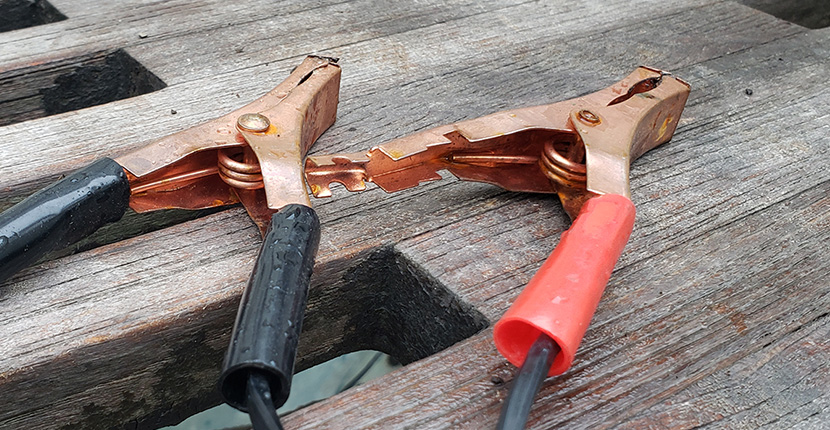What to Do if a Boat Battery Dies?
- by Bryan Veldboom - updated on 7/14/2022

There's nothing worse than getting ready for a day of boating, only to find that your engine won't start. When your car dies, you can jump start the battery using a set of jumper cables or a portable jump pack; but what about boats? Can you jump start a dead marine battery? Keep reading for valuable tips on how to safely jump start a dead boat battery.
Which Type of Marine Battery Can You Jump Start?
Boats typically have more than one type of battery onboard. The starting battery is the one responsible for turning over your engine. Some boat owners use a dual purpose battery to turn over the engine, instead of a traditional starting battery. Both of these battery types are safe to jump start. Once you do, your boat's alternator will begin charging them back up again.
Deep cycle batteries, however, should not be jump started. These batteries are typically used to power additional marine applications such as trolling motors, fish finders and any additional tech on your boat. Deep cycle batteries work much differently than starting batteries. In most cases, your deep cycle batteries will not be tied into your boat's charging system. Therefore, if you jump start a deep cycle battery it will die very quickly, since there's nothing to charge it after the jump. If you have a dead deep cycle battery on your hands, you need to attach it to a charger, so that it can power back up again.
Can You Jump a Marine Battery with a Car?
While it's technically possible to jump start a marine battery using a car or other vehicle, it's not a good idea. Marine batteries are different from auto batteries and attempting to jump start one using the other, could potentially cause damage to your batteries, your car or boat. It's best not to risk it.
The best way to jump start a marine battery is with a portable jump pack. A jump pack (also known as a jump starter or power pack) is essentially a portable battery with a pair of clamps attached. Using a jump pack is a safer option. Not only do you get a more consistent charging performance than you would from an auto battery, most jump packs also contain protection against things like reverse polarity and short circuits.
How Do You Find the Right Jump Pack for Your Boat?
When shopping for a jump pack, the main thing to look for is that the voltage of the jump pack matches the voltage of your battery. Most marine batteries are 12V, however both 24V and 36V batteries are sometimes used as well. You also want to make sure that your jump starter is compatible with the chemistry of your starting battery. That means if you have a flooded lead acid battery, be sure that the jump pack you select has a setting for that chemistry. Same rule if you have an AGM starting battery.
What are Some Jump Starters Available at Batteries Plus?
Batteries Plus offers a variety of portable jump packs both online and in store. Here are a few suggestions:
NOCO GB40 Genius Boost Plus 12V 1000A Lithium Jump Starter
- Jump starts gas engines up to 6 liters and diesel engines up to 3 liters
- Provides up to 20 jump starts before the unit must be recharged
- Features spark-proof technology and reverse polarity protection
- Can also be used to recharge phones & other devices; up to 4 smartphone charges
NOCO GB50 Genius Boost Plus 12V 1500A Lithium Jump Starter
- Jump starts gas engines up to 7 liters and diesel engines up to 4.5 liters
- Provides up to 30 jump starts before the unit must be recharged
- Features spark-proof technology and reverse polarity protection
- Can also be used to recharge phones & other devices; up to 6 smartphone charges
NOCO GB70 Genius Boost Plus 12V 2000A Lithium Jump Starter
- Jump starts gas engines up to 8 liters and diesel engines up to 6 liters
- Provides up to 40 jump starts before the unit must be recharged
- Features spark-proof technology and reverse polarity protection
How to Jump a Boat Battery
Follow these steps to safely jump start your dead starting battery:
- Connect the positive (red) clamp to the positive terminal of the dead battery.
- Connect the negative (black) clamp to the chassis ground of your boat.
- Press the power button to jump the battery (for most jump packs, a green or white light will illuminate if the battery is connected properly or a red error light will illuminate if connected improperly).
- Start your boat. If the engine doesn't start immediately, wait approximately 20-30 seconds to allow current to flow into the battery, then try again.
- Once the boat engine turns over, disconnect the clamps in the reverse order of how you connected them. Disconnect the negative (black) clamp first, then the positive (red) clamp second.
Have Your Marine Battery Tested at Batteries Plus
If you don't have any luck jump starting your battery, it may need to be replaced. Bring it to your nearest Batteries Plus location and we'll test it for you for free. If you need a replacement, we have an enormous selection of replacement marine batteries on hand, plus, top-quality battery chargers to help keep your batteries maintained.
Do you have additional questions about marine batteries? You'll find plenty of answers in both our Marine & Boat Battery Buying Guide and online blog. Some helpful topics include "How to Find the Right Battery Charger for Your Boat" and "How Does an Onboard Battery Charger Work on a Boat?"